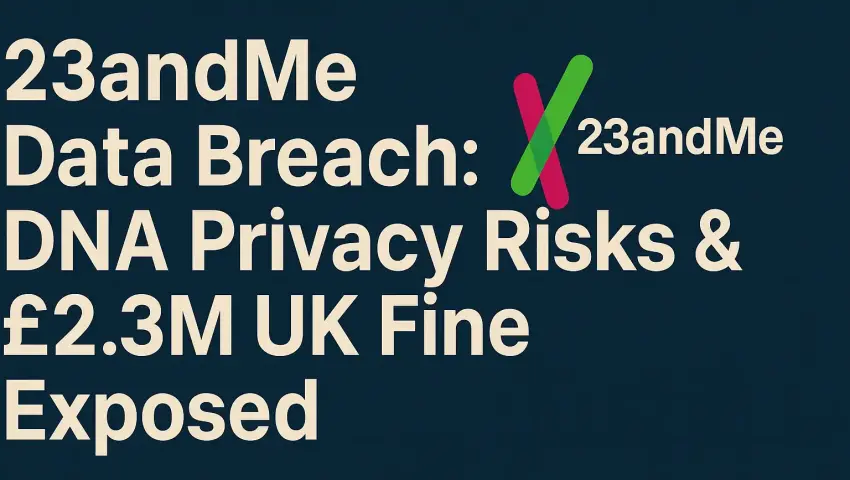
The Double-Edged Helix — The Rise of 23andMe and the Seeds of a Breach
We are living in the age of digital confessions and ancestry rabbit holes. From social media oversharing to home DNA kits, people are increasingly comfortable handing over the most intimate details of their lives—and their biology. At the forefront of this phenomenon stood 23andMe, a Silicon Valley darling founded in 2006 with a bold vision: to decode your DNA from a tube of saliva and tell you who you are, where you come from, and what might lie ahead.
Co-founded by Anne Wojcicki, a former biotech analyst with a sharp sense for market disruption, 23andMe offered something revolutionary: direct-to-consumer genetic testing. No doctor, no hospital—just curiosity, convenience, and a few clicks. For under $100, users could explore their ancestry, connect with long-lost relatives, and receive health reports that once required a lab and a specialist.
By the early 2020s, over 12 million people had spit into tubes and mailed their identities to Mountain View, California. The company’s DNA Relatives feature became a hub for family reunions and surprising revelations. But the very system that connected people so intimately was also stitching together a data web of enormous sensitivity—and vulnerability.

That vulnerability was exploited in 2023.
What began as a quiet warning in the cybersecurity underworld escalated into one of the most far-reaching genetic data breaches in history. Hackers used a method called credential stuffing—essentially reusing stolen usernames and passwords from past breaches—to quietly access 23andMe accounts. It wasn’t flashy, but it was devastating.
Once inside, the attackers didn’t just grab one profile at a time. Thanks to the interconnected nature of the DNA Relatives feature, access to one account could unlock connections to hundreds more. Like dominoes made of genetic code, the breach cascaded.
Globally, 6.9 million individuals were impacted. In the United Kingdom alone, 155,000 people had their sensitive personal information exposed—including their ethnic backgrounds, health predispositions, and family ties. It was a digital unzipping of human identity on a scale never seen before.
In the aftermath of the 23andMe breach, the silence was deafening. For weeks, users were left in the dark, unaware that their deepest personal information had been compromised. By the time the truth emerged, the damage was irreparable.
The Information Commissioner’s Office (ICO) in the UK launched an extensive investigation. Its findings were stark: 23andMe had failed to implement basic industry-standard safeguards. Multi-factor authentication was optional—not enforced. Password complexity requirements were weak. Even as alerts of suspicious logins mounted, the company took months to act decisively.
In May 2025, the ICO levied a £2.31 million fine against 23andMe, condemning not only the breach itself, but also the company’s sluggish response and systemic security failures. But perhaps more damning than the fine was the erosion of public trust. For a company built on the premise of self-knowledge and empowerment, the irony was brutal: it hadn’t truly known or protected its users.

And it didn’t stop at exposure.
Because of the platform’s DNA Relatives feature, accessing one account could reveal matches and family relationships across hundreds—sometimes thousands—of others. That meant users who hadn’t even logged in for years found their data swept into the breach. Entire family trees were exposed without consent.
As the legal clouds gathered, another dramatic twist unfolded: 23andMe, facing mounting lawsuits and a shattered reputation, filed for bankruptcy. It’s now being acquired by the TTAM Research Institute, a nonprofit backed by its co-founder Anne Wojcicki. The new leadership has promised to rebuild trust, improve security, and scale back the monetization of user data.
But the real question remains: Can you ever truly secure something as permanent as DNA?
Passwords can be reset. Emails can be changed. But your genetic blueprint is forever. What happens when it’s leaked into a shadowy digital underworld where anonymization is a myth and re-identification is a science?
The 23andMe breach has become a landmark case in the ethics of biotech and digital privacy. It’s forcing an entire industry to grapple with new questions: How much control should users have over their own data? Who gets to profit from genetic information? And when everything about you can be digitized, what parts of you are truly yours?
If this breach teaches us anything, it’s that data privacy isn’t just about devices anymore. It’s about identity. Legacy. Lineage. And protecting that isn’t just a technical challenge—it’s a moral imperative.
Sources:
Information Commissioner's Office (ICO) Official Statement – May 2025
23andMe Press Release on Breach and Legal Proceedings – April 2024
TechCrunch – “23andMe’s Data Breach Exposed Genetic Links of Millions,” November 2023
BBC News – “UK Fines 23andMe £2.3 Million Over Data Breach,” May 2025
The Guardian – “DNA Doesn’t Expire: The Unseen Cost of 23andMe’s Data Leak,” May 2025




